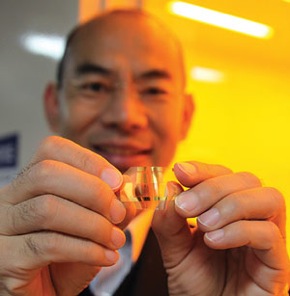Fast, flexible electronics for the next generation of gadgetry
This year’s thin, powerful smartphone quickly becomes yesterday’s underperforming battery hog in today’s consumer electronics market.
The demand for smaller devices with more features and increased battery life seems insatiable-and electrical and computer engineering Professor Zhenqiang (Jack) Ma is keeping up with that pace, working tirelessly to improve the technology that could power the next generation of mobile electronics.

Zhenqiang “Jack” Ma displays some flexible electronics.
Ma’s work centers on fast, flexible electronics-circuits that can bend to any shape without sacrificing performance. He’s been refining techniques for designing chips on silicon nanomembranes, developing faster methods of “carving” circuitry into these thin, stretched layers of insulated silicon using patterned adhesive membranes to pull off layers of insulation. “They use a single crystal material, which offers a much higher speed than can be realized using other materials,” says Ma, of his devices. “So far, we have gotten as high as 12 gigahertz (GHz).”
A typical smartphone runs at around 2 GHz, but the benefit of integrating fast, flexible electronics into future smartphone designs isn’t just about increases in speed. Huge improvements in battery life are possible, as well.
“You take a 12 GHz flexible transistor and run it at 2 GHz, and a 3 GHz rigid transistor and run it at 2 GHz. The power consumption will be one or two orders lower for the flexible chip,” says Ma.
The flexibility of these chips gives them much wider applications than better versions of the tech we already have; they’re well suited for everything from small-scale wireless communications to more comfortable, reliable biomedical devices.
“Because they are flexible, you can put them anywhere you want-on your skin, your clothes, wherever,” says Ma. “The applications are very, very broad.”
Enjoy this story?
Read more news from the College of EngineeringTags: College of Engineering, research
